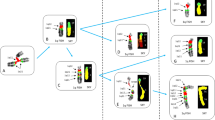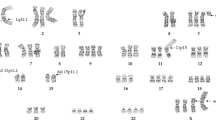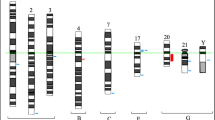Abstract
CYTOGENETIC studies of human lymphocytes cultured from patients and their families using known banding methods 1–2 provide an opportunity to observe spontaneous chromosomal aberrations to identify the chromosomes involved in are arrangement and aid in interpreting the cytogenetic events leading to their formation. In our investigations of many high risk families over a 4-yr period all breaks fragments and rearrangements noted in the lymphocyte cultures were recorded along with the total number of cells counted because of previous experience in the study of X-ray induced chromosomal aber rations4,5. The observations reported here are from 72-h cultures which may complicate their interpretation6,7 since they are subject to the selective advantages or disadvantages of a particular chromosomal rearrangement and other factors. The many variables inherent in the analysis preclude rigorous statistical treatment of these data but a general description of the nature of occurrence may be helpful.
This is a preview of subscription content, access via your institution
Access options
Subscribe to this journal
Receive 51 print issues and online access
$199.00 per year
only $3.90 per issue
Buy this article
- Purchase on Springer Link
- Instant access to full article PDF
Prices may be subject to local taxes which are calculated during checkout
Similar content being viewed by others
References
Seabright, M., Lancet, i, ii. 971–972 (1971).
Sumner, A. T., Evans, H. J., and Buckland, R. A., Nature new Biol., 232, 31–32 (1971).
Caspersson, T., Zech, L., and Johannsson, C., Expl Cell. Res., 62, 490–492 (1970).
Beatty, A. V., and Beatty, J. W., Proc. natn. Acad. Sci. U.S.A., 46, 1488–1492 (1960); 49, 434–439 (1963); Radiat. Res., 27, 347–354 (1966).
Beatty, A. V., in Recovery and Repair Mechanisms in Radiobiology, Brookhaven (Upton, N. Y.) Symposia in Biology, 20, 98–110 (1967).
Evans, H. J., Proc. R. Soc. Edin., 70, 132–151 (1968).
Bender, M. A., and Brewen, J. G., Mutat. Res., 8, 383–399 (1969).
Paris Conference (1971) Standardization in Human Cytogenetics. Birth Defects: Original Article Series, VIII (7) (The National Foundation, New York, 1972).
Evans, H. J., in Advances in Physical and Biological Radiation Detectors, 593–609 (I.A.E.A., Vienna, 1971).
Welch, J. P., and Lee, C. L. Y., Nature, 255, 241 (1975).
Hecht, F., McCaw, B. K., Peakman, D., and Robinson, A., Nature, 255, 243 (1975).
Levan, A., in Nobel Symposia, Medicine and Natural Sciences, 23, (edit. by Caspersson, T., and Zech, L.), 217–229 (Academic, New York and London, 1973).
Hecht, F., McCaw, B. F., and Koler, R. D., New Engl. J. Med., 289, 286–291 (1973).
Bender, M. A., Griggs, H. G., and Bedford, J. S., Mutat. Res., 23, 197–209 (1974).
Author information
Authors and Affiliations
Rights and permissions
About this article
Cite this article
BEATTY-DESANA, J., HOGGARD, M. & COOLEDGE, J. [Letters to nature]. Nature 255, 242–243 (1975). https://doi.org/10.1038/255242a0
Received:
Accepted:
Issue Date:
DOI: https://doi.org/10.1038/255242a0
Comments
By submitting a comment you agree to abide by our Terms and Community Guidelines. If you find something abusive or that does not comply with our terms or guidelines please flag it as inappropriate.



